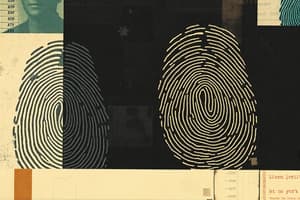Podcast
Questions and Answers
What is the most common type of fingerprint?
What is the most common type of fingerprint?
loop
Patent prints must be dusted or chemically treated in order to identify the ridge pattern and minutiae.
Patent prints must be dusted or chemically treated in order to identify the ridge pattern and minutiae.
True (A)
Whorls are the most common form of fingerprints.
Whorls are the most common form of fingerprints.
False (B)
No one has found two people with more than 8 minutiae in common.
No one has found two people with more than 8 minutiae in common.
It is necessary to obtain a full print from a suspect in order to match his fingerprint with a fingerprint found at the crime scene.
It is necessary to obtain a full print from a suspect in order to match his fingerprint with a fingerprint found at the crime scene.
Fingerprints are formed within the basal layer of the skin.
Fingerprints are formed within the basal layer of the skin.
Identical twins have matching fingerprints.
Identical twins have matching fingerprints.
Fingerprints that are actual indentations left in some soft material such as clay or putty are referred to as?
Fingerprints that are actual indentations left in some soft material such as clay or putty are referred to as?
What program provides digital, automated fingerprint searches for the FBI?
What program provides digital, automated fingerprint searches for the FBI?
What are the three basic fingerprint patterns?
What are the three basic fingerprint patterns?
Explain the terms visible, plastic, and latent fingerprints.
Explain the terms visible, plastic, and latent fingerprints.
What are minutiae and why are they important to fingerprinting?
What are minutiae and why are they important to fingerprinting?
What makes fingerprints reliable evidence to use in court? What determines whether a fingerprint is a true match?
What makes fingerprints reliable evidence to use in court? What determines whether a fingerprint is a true match?
Explain two ways of visualizing latent prints.
Explain two ways of visualizing latent prints.
Which chemical can be used on wood or Styrofoam and turns a print black or brown?
Which chemical can be used on wood or Styrofoam and turns a print black or brown?
AFIS contains approximately how many fingerprint records?
AFIS contains approximately how many fingerprint records?
The FBI has found that no two individuals have?
The FBI has found that no two individuals have?
Whose fingerprint identification method is still used today?
Whose fingerprint identification method is still used today?
The computer searches the AFIS system and produces a list of file prints that match closest with search print; this takes approximately how long?
The computer searches the AFIS system and produces a list of file prints that match closest with search print; this takes approximately how long?
In what year did the FBI develop the Integrated Automated Fingerprint Identification System (AFIS)?
In what year did the FBI develop the Integrated Automated Fingerprint Identification System (AFIS)?
What is a core?
What is a core?
Eccrine glands are primarily located on the ridges of the?
Eccrine glands are primarily located on the ridges of the?
Iris identification systems take only how long to scan the iris and look for patterns?
Iris identification systems take only how long to scan the iris and look for patterns?
Every fingerprint is different.
Every fingerprint is different.
Which patterns have a delta?
Which patterns have a delta?
What does AFIS stand for?
What does AFIS stand for?
What is the least common fingerprint?
What is the least common fingerprint?
What layer is the fingerprint in?
What layer is the fingerprint in?
Flashcards are hidden until you start studying
Study Notes
Fingerprint Basics
- The most common type of fingerprint is a loop.
- Three basic fingerprint patterns: Loop, Arch, Whorl.
- The least common fingerprint pattern is an arch.
Types of Fingerprints
- Visible (patent) prints can be seen without enhancement.
- Plastic prints are actual indentations left in soft materials (like clay).
- Latent fingerprints are not visible and require fuming or chemical treatments to reveal.
Fingerprint Characteristics
- Minutiae refer to small details in fingerprints, includes ridge endings and bifurcations.
- No two individuals have more than 8 common minutiae, making fingerprints reliable for identification.
- Fingerprints are formed in the basal layer of the skin, ensuring uniqueness among individuals.
Identification Processes
- AFIS (Automated Fingerprint Identification System) enables digital searches for fingerprint identification, containing approximately 50 million records.
- The search process in AFIS takes about 2 hours to match fingerprints.
- Iodine fuming and ninhydrin are methods used for visualizing latent prints.
Chemical Treatments
- Silver nitrate is effective on wood or Styrofoam, turning prints black or brown.
- The core is the center of a loop or whorl pattern in fingerprints.
Miscellaneous Facts
- Identical twins do not share the same fingerprints.
- Eccrine glands, related to fingerprints, are primarily located on the hands and feet.
- Iris identification systems can scan and recognize patterns in just 2 seconds.
- The fingerprint layer is referred to as the dermal layer.
Historical Context
- The fingerprint identification method developed by Sir Francis Galton is still utilized today.
- In 1999, the FBI developed the Integrated Automated Fingerprint Identification System (AFIS).
True/False Statements
- Patent prints require dusting or chemical treatment to identify ridge patterns. (True)
- It is necessary to have a full print from a suspect to match fingerprints found at a crime scene. (False)
- No one has found two people with more than 8 minutiae in common. (True)
- All fingerprints are different. (True)
Studying That Suits You
Use AI to generate personalized quizzes and flashcards to suit your learning preferences.




